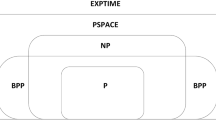Abstract
A number of phenomena generally believed characteristic of quantum mechanics and seen as interpretively problematic—the incompatibility and value-indeterminateness of variables, the non-existence of dispersion-free states, the failure of the standard marginal-probability formula, the failure of the distributive law of disjunction and interference—are exemplified in an emphatically non-quantal system: a deck of playing cards. Thus the appearance in quantum mechanics of incompatibility and these associated phenomena requires neither explanation nor interpretation.
Similar content being viewed by others
REFERENCES
M. Jammer, The Philosophy of Quantum Mechanics (Wiley, New York, 1974).
H. Margenau, “Measurements in quantum mechanics,” Ann. Phys. 23, 469-485 (1963).
J. E. G. Farina, “An elementary approach to quantum probability,” Am. J. Phys. 61(5), 466-468 (1993).
R. P. Feynman, R. B. Leighton, and M. Sands, The Feynman Lectures on Physics, Vol. III (Addison-Wesley, Reading, MA, 1965).
D. Z. Albert, Y. Aharonov, and S. D'Amato, “Curious new statistical prediction of quantum mechanics,” Phys. Rev. Lett. 54(1), 5-7 (1985).
K. A. Kirkpatrick, “Classical three-box ‘paradox’,” J. Phys. A 36(17), 4891-4900 (2003); arXiv: quant-ph/0207124.
J. S. Bell, “On the problem of hidden variables in quantum mechanics,” Rev. Mod. Phys. 38(3), 447-452 (1966).
S. Kochen and E. P. Specker, “The problem of hidden variables in quantum mechanics,” J. Math. Mech. 17(1), 59-87 (1967).
M. Redhead, Incompleteness, Nonlocality, and Realism (Clarendon Paperbacks, Oxford, 1989).
B. d'Espagnat, Veiled Reality (Addison-Wesley, Reading, MA, 1995).
A. Fine, “Joint distributions, quantum correlations, and commuting observables,” J. Math. Phys. 23(7), 1306-1310 (1982).
Author information
Authors and Affiliations
Rights and permissions
About this article
Cite this article
Kirkpatrick, K.A. “Quantal” Behavior in Classical Probability. Found Phys Lett 16, 199–224 (2003). https://doi.org/10.1023/A:1025910725022
Published:
Issue Date:
DOI: https://doi.org/10.1023/A:1025910725022




